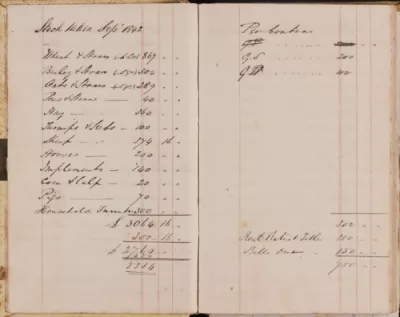Farmer John White and Project HARVEST
Understanding the business success of a Rickmansworth Victorian farmer

Project HARVEST - co-production with the University of Hertfordshire
When we were given the diaries of the Rickmansworth farmer John White we knew they were valuable – but we had no idea just how much detail they contained. And next to them are the accounts, and a huge amount of other material. The whole collection will shine a wonderfully strong light on the work and business, the life and family of a very well-known local man, and provide a new insight into what life was like, for many people, in this area in the second half of the nineteenth century.
All that material has been used by students of the Business School of the University of Hertfordshire in Project HARVEST, which we launched at the museum on 18th April 2024 and which closed at the end of December. The project has used this wonderfully rich collection to explore how this diary-keeping farmer survived the agricultural depression of the 1870s when so many struggled, and to extract lessons on how we can improve the environmental sustainability of food production in the future.
It was made possible by funding from the Arts and Humanities Research Council (AHRC) Impact Acceleration Grant, administered by the University. It’s been a real community project, with the university’s staff and students working with the museum’s volunteers to produce both knowledge for everyone, extra experience for the volunteers, something new for the students and an exhibition for the museum’s visitors.
Just to give some examples: Mr White valued the whole stock on his farms (he had Parsonage, Two Stones and, from 1873 to 1894, Parrotts at Croxley Green) every September. Dull figures? Not when you see his working horses, with their names, listed, along with his cattle, sheep, grain and machinery. And at least some of his cows had names, and he recorded when they calved in the same way as he did the birth of his own grandchildren and (later) great grand-children.


And he noted carefully the deal he did for the rent on Parrotts Farm at Croxley Green – it was to vary with the price of grain, which was the main output from that farm: the higher the price of wheat, the higher the rent, up to a stated limit.
“… the rent of Parrotts Farm … upon the following terms … when the average price of Wheat for the year is below 45/- per Qr the yearly rent is to be £200. When it reaches 45/- per Qr. the rent is to be £220 & when the average price is at 50/- per Qr. the rent is to be £240 and if the average price shd reach 56/- for the year then the rent is to be £260, but in any Case £260 is to be the maximum and £200 the minimum.”
And so with this and the other data the students tracked the rising and falling value of the business over the years from 1841 to 1875. The end is significant – the years from about 1873 for about twenty years saw a terrible depression in English agriculture, due in large part to really bad weather – wet and cold in the winters, either very wet or very cold and dry in the summers. This was accompanied by the development of steam shipping, which allowed imports of foodstuffs of all sorts from America and Canada, Australia and New Zealand, Russia and Ukraine – just as British farming was struggling, and suffering really serious diseases of cattle and sheep at the same time.
The image below captures the problem exactly. In Rickmansworth Church Street in the 1880s appeared the shop of the New Zealand Mutton Company, importing and selling frozen New Zesaland meat!

And yet John White, without doubt a Victorian gentleman farmer, was able to prosper, when many of his colleagues (especially those further afield, but also some nearby) were hit hard.
So how was John White able to do relatively well? What ‘sustainability’ lessons might we learn, both at the level of the individual farmer and at the higher levels of policy-making and practice? Project HARVEST has allowed the UH students to make inroads into this very large problem, which will keep us all going for many years to come.
More details about the project can be found here - https://lnkd.in/eksSY-ip .